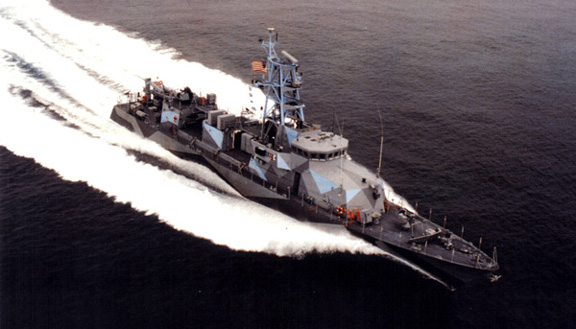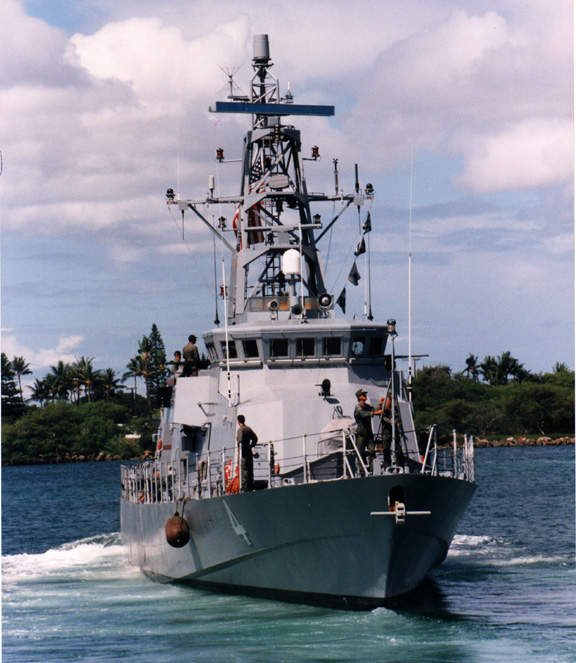Patrol Craft Sailor Association
INFORMATION ON THE CYCLONE CLASS PCs AND WPCs
Cyclone-Class Patrol Coastal
*The Navy is replacing one Mk.38 with a new Mk.96
platform CYCLONE-CLASS PC HISTORYIn 1990, the Navy awarded a contract to Bollinger Machine Shop and Shipyard of Lockport, LA for construction of eight Patrol Coastal (PC) ships based on the Vosper Thornycroft Patrol Craft hull design. A follow-on contract for five additional ships was executed in July 1991. In October 1997, Bollinger was awarded a contract to build a fourteenth Patrol Coastal ship. Plans called for the keel to be laid in June 1998 with delivery in April 2000. Construction of the ships was funded by the United States Special Operations Command (USSOCOM). The ships are manned by Naval personnel and are assigned to the Naval Special Warfare Command under the cognizance of Special Boat Squadron ONE (Coronado, CA) and Special Boat Squadron TWO (Little Creek, VA). The mission of the Patrol Coastal ships is to conduct Maritime Special Operations, to include: maritime interdiction operations, forward presence, escort operations, noncombatant evacuation, foreign internal defense, long-range Special Operations Forces (SOF) insertion/extraction, tactical swimmer operations, reconnaissance, intelligence collection, operational deception and SOF support as required. The ship's operational capabilities are designed to meet the unique requirements of their Special Warfare missions. Operationally, the PC's are capable of accelerating from stop to 35 knots in under three minutes, then move from full ahead to 15 knots astern in 60 seconds. In high-speed, hard-over turns, the ship barely heels as the automatic stabilizers engage. The PCs are named for global weather phenomena with the first ship in the class being USS CYCLONE. CYCLONE-CLASS PC's
PC TIDINGS:The PCs of Special Boat Squadron ONE have been deployed to South American countries with operations in the South-eastern Pacific, South Atlantic and the Caribbean. On a deployment to Ecuador in 1996, HURRICANE and MONSOON navigated 42 nautical miles up-river to Guayaquil, proving the PC ability to operate in a riverine environment. In 1997, SQUALL and ZEPHYR completed a six-montb deployment in support of Exercise UNITAS 38-97, including the circumnavigation of the South American continent and operations with twelve nations. During this exercise, the ships covered 22,000 nautical miles and visited over 30 ports while carrying out operations in support of Maritime Special Operations, Coastal Patrol and Interdiction and amphibious events. In1998, HURRICANE and MONSOON conducted the first deployment of PCs to the Western Pacific (Wes Pac) since World War II. Accompanied by USS SIdes (FFG 14) the PCs logged over 22,500 nautical miles and visited Hawaii, Okinawa, Japan, South Korea, Hong Kong, Malaysa, Singapore, Thailand and Guam. Special Boat Squadron TWO PCs have been deployed to Europe and Africa, participating in Sixth Fleet operations in the Mediterranean and Persian Gulf and joint operations with allied Navies in the Mediterranean, South Atlantic, North Atlantic and Baltic Sea. In 1996, TYPHOON and SIROCCO visited eleven European nations, working with the Navies of Albania, Denmark, Finland, Germany, Latvia, Lithuania, the Netherlands, Poland, Portugal, Russia, Spain and Sweden. The ships called on 18 foreign ports including the first ever U. S. Navy ships to visit St. Petersburg, Russia. The PCs of Boat Squadron TWO have shown the flag from Dakar, Senegal to St. Petersburg, Russia. On October 1, 2002 the 9 East Coast PCs were transferred to the Commander, Naval Surface Force, Atlantic Fleet (SURFLANT) and the 4 PCs on the West Coast transferred to the Naval Surface, Pacific (SURFPAC). All 13 PCs are currently deployed with the U.S. Coast Guard in support of Operation Noble Eagle, homeland security of our coastline, harbors and ports. Following the terrorist attacks on the World Trade Center and the Penatgaon on 11 September 2001, the PCs were assigned to operate with the U.S. Coast Guard on Homeland Defense duties. The ships are manned and maintained by the Navy but are under Coast Guard operational control. In January 2003, USS Chinook (PC 9) and USS Firebolt (PC 10) along with their Maintenance Support Team, were deployed to the Persian Gulf and operated in the region during the Iraq war. They were relieved in mid-2004 by USS Typhoon (PC 5) and Sirocco (PC 6) along with their respective Maintenance Support Team. The Typhoon and Sirocco are presently on station in the Persian Gulf with their crews rotated under the Navy's experimental Sea Swap Program. The concept of the Sea Swap Program is that it is cost effective and less time consuming to swap out the entire crew, from Captain to Seaman, of a forward deployed ship than to bring the ship back on rotation. The plan calls for the ships to remain on station for up the 18 months, with the crews rotated on six-month intervals. On 30 September 2004, five PCs, USS Tempest (PC 2), USS Monsoon, (PC 4), USS Zephyr, (PC 8), USS Shamal, (PC 13), USS Tornada, (PC 14) were decommissioned and transferred to the U.S. Coast Guard, on loan for four years. The Navy will retain ownership of the PCs and be responsible for all life-cycle management maintenance, depot management and corrective services through fiscal 2008. The remaining eight Navy PCs, six stationed at NAB Little Creek, VA and two at NAB Coronado, CA will continue to operate with the Coast Guard on Homeland Defense duties. NAB Little Creek will provide the ships for Persian Gulf deployment and crews from both NAB Little Creek and NAB Coronado will be supporting the Sea Swap Program.
USS MONSOON (PC-4) on deployment to Hawaii
U. S. COAST GUARD PATROL COASTALS (WPCs)On 1 October 2004, the five Patol Coastals transferred from the Navy were recommisioned in the Coast Guard and designated as Coast Guard Cutters. Their names and hull numbers remained the same with the ships now designated as WPCs. In August 2008, Patrol Coastals Tempest (PC 2) and Monsoon (PC 4) were transferred back to the U.S. Navy and are now based at the Patrol Coastal Training Facility at NAB Little Creek, Virginia In 2011, CGC Tempest WPC-2, and CGC Monsoon WPC-4 were decommissioned and returned to the Navy. CGCs Zephyr, Shamal and Tornado remain in active service by the Coast Guard.
WPCs IN ACTIONOn 13 February 2005, CGC Shamal (WPC 13) returned to Pascagoula after a five-week patrol in the Caribbean Sea. It was Shamal's first operational patrol as a Coast Guard cutter since being transferred from the Navy. While on patrol with the Dominican Republic frigate Altair, Shamal seized more than 2,000 pounds of cocaine and 2,000 pounds of maijuana from two different drug seizures and arrested several suspects for drug trafficking.
All Patrol Craft Sailors are "Too
Good To Be Forgotten." Short-cut to: Web design by Chris Matyas. Editor, Mark Matyas. Patrol Craft Sailors Association © copyright 2005-20, all rights reserved
|
||||||||||||||||||||||||||||||||||||||||||||||||||||||||||||||||||||||||||||||||||||||||||||||||||||||||||||

